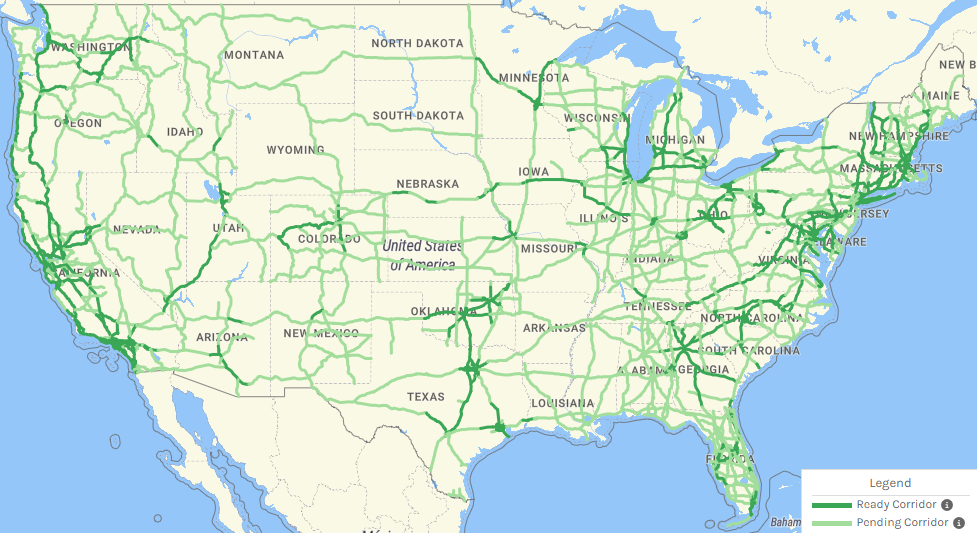 Designated Alternative Fuel Corridors for Electric Charging Stations. Department of Energy Image
Designated Alternative Fuel Corridors for Electric Charging Stations. Department of Energy Image
Future of U.S. Transition Toward Electric Vehicles
Tesla’s share of electric vehicle (EVs) sales, which previously dominated the market, slipped below fifty percent for the first time in the second quarter of 2024. Combined with the uneven sales growth of EVs compared to previous years, it is evident that the EV market is changing. In the immediate term, auto manufacturers joining the transition toward EVs must balance the cost of EV development with continued market demand for internal combustion engine (ICE) cars. The U.S. government needs to coordinate with auto companies to ease consumer hesitancy about making the switch to EVs as they become the future of the automobile industry. Balancing vehicle pricing and pursuing infrastructure upgrades will help smooth the green energy transition.
The electrification of U.S. transportation is critical to President Biden’s plan to halve greenhouse gas emissions by 2030, which includes making EV sales 50 percent of all new vehicles sold by the same date. To reach this point, the U.S. electrical grid needs a massive upgrade to support the future increase of EVs and their chargers, which by 2035 is estimated to demand 3,360 percent more electricity than usage today. If electricity demand outpaces current grid capabilities, EV drivers will suffer from long lines at limited charging stations. It is a common misperception that the increased electricity demands will pollute just as much if not more than ICE car emissions due to electric power plants. However, the Environmental Protection Agency reports that charging EVs produces lower levels of emissions than the average ICE car even if the power generation uses coal or natural gas.
Another major challenge is to convince the public that switching to EVs is more practical and financially responsible than continued reliance on ICE cars. Drivers remain hesitant due to concerns about higher costs and charging station accessibility. Daunted by an initially higher purchasing price, buyers do not realize the long-term financial benefits of owning an EV, which include cheaper prices for charging instead of fueling, tax incentives, and lower maintenance costs. As more Americans keep their cars longer than before, EVs are more cost-effective in the long run.
Despite these obstacles, a project of this massive scale to transform U.S. transportation has been accomplished before. The revolution to make the United States car-centric can be traced through the spread of gas stations and the Federal-Aid Highway Act of 1956, which funded the construction of the Interstate Highway System. The expansion of the road network and gas station infrastructure supported the growing use of automobiles. Before that, the introduction of Henry Ford’s assembly line production made cars more affordable for the average American. Parallel developments to change American infrastructure and the market for EVs are possible.
The growth and diversification of the EV market have brought in established companies such as BMW and Ford, who are pulling more consumers due to their large dealer networks that can provide service. Since Tesla models are sold online, customers have reported difficulty accessing service centers. Although no other car company besides Tesla has been able to sell more than 100,000 EVs annually in prior years, Hyundai, General Motors, and Ford are all set to reach that number this year, changing the competition in the American EV market. Currently, there are over a hundred EV models available in the United States. Affordable prices, increased supply, and more variety in models help make EVs increasingly attractive to the average buyer.
The Biden administration has taken several steps to overcome pricing and charging infrastructure issues. The administration has expanded the New Clean Vehicle Tax Credit to include used EVs through the Inflation Reduction Act. Last year, the U.S. government opened applications for the Electric Vehicle Charger Reliability and Accessibility Accelerator which will provide up to $100 million in federal funding to repair EV charging infrastructure. The Bipartisan Infrastructure Law is investing $5.5 billion into the National Electric Vehicle Infrastructure program to build chargers every 50 miles along the American network of roads and $2.5 billion into state and local grants to make up for charging station gaps. These targeted investments will complement hundreds of billions in private sector investment and make the current charging network more reliable.
The shift from ICE cars to EVs requires significant collaboration between the U.S. government and auto companies. Ensuring that EVs become more affordable and appealing to American consumers while meeting environmental goals is no small task, but it is not impossible. Although considerable progress has been made as the EV market steadily grows, more effort can be made to ensure that the investment into infrastructure and EV development is smooth and cost-effective.






